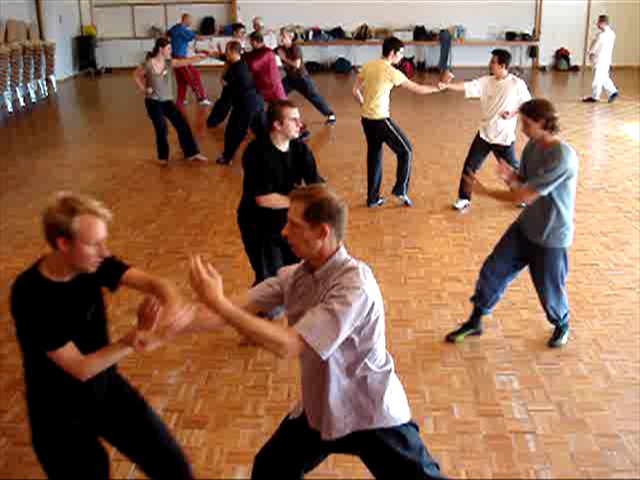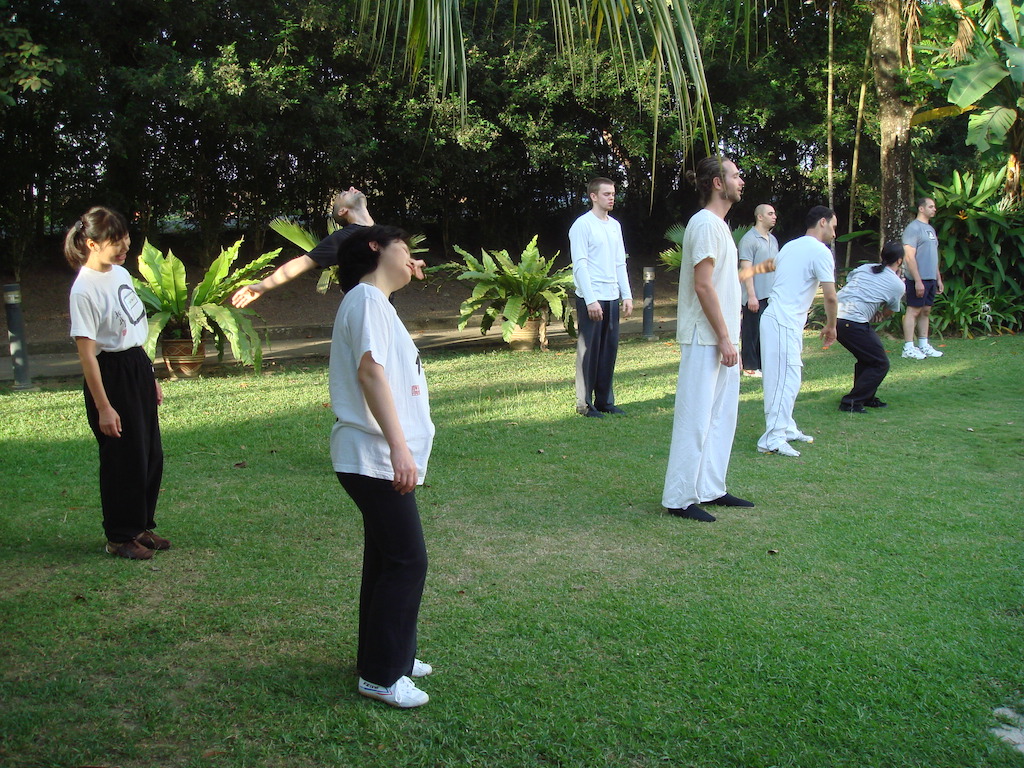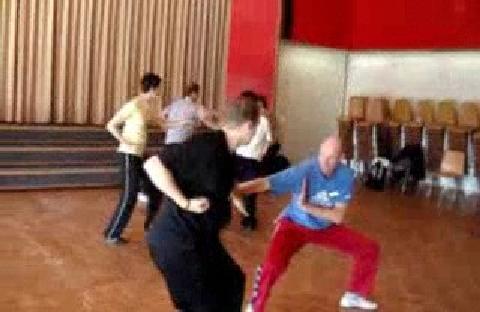January 2007 (Part 1)
SELECTION OF QUESTIONS AND ANSWERS

Our school, Shaolin Wahnam, is one of the very few kungfu schools in the world today that still uses kungfu forms, and not Karate or Kick-Boxing, for sparring.
Question 1
I am waiting to learn Shaolin Kungfu but really nobody knows anything about Shaolin in my country. There are only Karate and Taekwondo schools here. I know a little Wing Chun. I buy Shaolin DVD or CD. Can you help me?
— Mustafa, Turkey
Answer
Genuine Shaolin Kungfu is very rare today, even in China! What is being taught in China today is mainly modernized wushu, which is different from traditional kungfu.
Traditional kungfu of various styles were brought out of China by many masters in the past two centuries. Luckily these masters brought genuine kungfu out of China to many countries, especially to Southeast Asia, North America, Europe and Australia where there were substantial overseas Chinese communities. If it had only remained in China, it might be totally lost during the period of Cultural Revolution in China in the 1960s when anything traditional was considered counter-revolutionary, which was the biggest crime in China at that time.
However, due to numerous factors, much of the traditional kungfu outside China became greatly debased. In most cases only the outward forms remain, the essence is lost. There are two aspects of the essence, internal force and combat application. As a result, today we have a great majority of kungfu practitioners who can only perform beautiful kungfu forms but have no internal force and cannot apply their kungfu for combat.
Some of them borrow sparring methods from Karate and Taekwondo, and more recently from Kick-Boxing. These kungfu practioners are able to fight, but they use Karate, Taekwondo or Kick-Boxing techniques. A few even reach a point where they believe kungfu cannot be used for fighting!
This is the pathetic situation of kungfu today. There are three main categories of Chinese martial art practitioners. One, there are those who practice modernized wushu, a demonstrative art invented by the present Chinese government in the 1970s. Two, those who practice traditional kungfu forms but have no sparring experience at all. Three, those who use Karate, Taekwondo or Kick-Boxing for sparring.
We in Shaolin Wahnam belong to the rare minority who still have this essence of internal force and combat application. We are also among the more vocal as well as willing to share our arts with others. Most of this rare minority prefer to keep their arts as secrets, and of course it is their right to do so.
Understandably, many people attack us relentlessly. Some do so out of disbelief, and some out of self-interest. We remain steadfast in our policy. We sincerely believe we have a treasure to share, but only with deserving seekers. We therefore do not wish to waste time arguing with those who prefer to practice only outward forms or use Karate, Taekwondo and Kick-Boxing for sparring. They too have their own right to practice what they want.
If you are interested to practice traditional Shaolin Kungfu that uses internal force and kungfu techniques for sparring, we shall be happy to share the art with you if you follow the Ten Shaolin Laws. A good way is for you to first learn some basic kungfu forms from some local teachers or from my books, and then attend my Intensive Shaolin Kungfu Course. Hopefully you may one day spread the wonderful Shaolin arts in your country.
Question 2
I have some problems with my chi kung. I cannot meditate. I want to but I cannot. It seem to me that I hate chi kung.
— Gasham, USA
Answer
You should not force yourself to practice chi kung. If you hate chi kung, then you should not practice it; you should choose some other activities that you like, such as playing games, swimming or wushu.
Your problem, however, is probably due to your approach to chi kung. I presume you learn chi kung from books. You should learn from a teacher who makes the art interesting and rewarding. It is of course not easy to find such a teacher, but if you know what you are looking for and are prepare to spend some time searching, you will find him.
Question 3
I was training “Pushing Mountains” and I achieved a very good chi flow to my arms. But I cannot continue now. I have no patience any more. I feel depressed because my flow is too weak.
Answer
If you wish to practice chi kung, you need to have patience. Otherwise, chi kung is not for you. On the other hand, patience can be cultivated by practicing chi kung, especially if you have a good teacher.
You have a mistaken concept of chi kung. You seem to seek novel effects in chi kung rather than its practical benefits. We practice chi kung not just because we want to enjoy powerful chi flow or other novel effects like seeing beautiful lights and feeling rooted to the ground.
Although these feelings are enjoyable and indicate that we are practicing correctly, they are not the real reasons why we practice chi kung. The real reasons are that we want to be free from pain and illness, have mental freshness and vitality to enjoy work and play, and live to a ripe old age healthily.
If you have powerful chi flow in your arms or experience other novel sensations but still remain sickly or are in pain, you would have wasted your time practicing chi kung. On the other hand, you may not experience any special sensations but enjoy good health, vitality and longevity, then you would have spent your time practicing well.
On the other hand, even for dedicated practitioners there are ups and downs in chi kung training.
Don't be discouraged when sometimes you feel you are not getting good results. Some good advice generations of masters have given is not to worry about your result but just enjoy your practice. If you practice regularly and correctly, the good results will sure to come. Hence, you need to have patience, and practicing chi kung develops patience.
Even when you are deriving good results from your regular training, there may still be times when your results are not as good as usual. In other words, there may still be ups and downs, except that the ups are much more than the downs. Besides, the downs now are better than the ups in the past.
We shall have a clear idea if we use numbers to represent results, the higher the number the better the result. Suppose you start at O. After a few days of practice you arrive at 1 and 2, but there may be a day or two when you are at 0 or even -1.
After a few weeks you may be at 3, 4 or 5 but there may be occasions when you may be at 1 or 2. After a few months you may be at 8 and 9, but once a while you may drop down to 6 or 7, or even 4 or 5. Now 6 and 7 are your low periods, and 4 and 5 your very low periods, but they are still higher than 1 and 2 when you first started.

The improvement in the teaching methods of our school is quite incredible. It took more than a year of diligent training for Sifu Wong himself to experience a chi flow. But now Shaolin Wahnam students can experience a chi flow within a few weeks of regular class training, and in intensive or regional courses like this one, course particpants experience a chi flow on the very first day!
Question 4
Is Da Mo's Muscle Metamorphosis and Sinew Metamorphoses the same, and have you ever heard about the art of Guan Yin Palm?
Answer
Muscle Metamorphosis and Sinew Metamorphosis are the same. This set of exercise is also called Tendon Changing Classic.
Yes, I have heard of Guan Yin Palm in kungfu stories and movies, but have not seen it in real kungfu training.
Question 5
I would like to start off by saying thank you for all the information you have provided me in your books and in your question section on your website. I hope I can one day be as great a master as you.
— Cesar, Spain
Answer
Thank you for your kind words.
It may be motivating for aspiring students to know that not only anyone can attain what I have attained if they have the right methods and train diligently, my students would attain my level in less than one-third the time I took. In some cases they may attain the same result in less than one-tenth of the time. It is incredible but true.
For example, it took me more than a year to be able to generate an internal chi flow, and that was a remarkable achievement, considering that chi flow is essential in chi kung and that many other practitioners cannot generate a chi flow even after many years. Students at my Intensive Chi Kung Course are able to generate their chi flow on the first day of the course!
It took me a few years before I could use kungfu to spar effectively. This was a remarkable achievement, considering that today most kungfu practitioners cannot use their kungfu to spar at all even after practicing for many years. But students who learn Shaolin Kungfu and Wahnam Taijiquan from me or from our certified instructors can use Shaolin Kungfu or Taijiquan to spar reasonably well after a year.
At my recent regional Shaolin Kungfu courses in Andorra, Switzerland and Finland in August and September 2006, students including fresh beginners without prior martial art experience could use kungfu skills and techniques in free sparring after just three days of training! You can view some video clips of their free sparring here.
Understandably the beginners could not spar well, they would be easily beaten by Karate or Taekwondo black-belts. But this is not the issue; the issue is that they could use kungfu techniques in their free sparring. If they continue training for a year, they should be able to handle the black-belts quite comfortably.
Today, many martial art practitioners, including masters, would be very happy if they could develop internal force after a few years of daily training. Hence, when I experienced some internal force after a few months of training, it was a considerable achievement. Yet, most students who learn Shaolin Kungfu or Wahnam Taijiquan from me or our certified instructors today experience internal force after only a few days, and some after the first day, of stance training.
Question 6
I injured my right knee about six weeks ago. It hurt all the time. Now it only hurts when I bend my leg more than half ways or when I turn my foot to the left.
I have read your book Chi Kung for Health and Vitality. I know learning from a book is nothing compared to learning from a master, and can make things worse, but I wanted to ask if I were to practice “Lifting the Sky” would it heal me of my knee pain? Or should I just wait and find a chi kung master?
Answer
If you practice correctly, you can overcome your leg injury and pain by practicing “Lifting the Sky”. “Practicing correctly” would include a session of chi flow after you have completed about 20 repetitions of “Lifting the Sky”.
Nevertheless, in your case, performing “Rotating Knees” and “Deep Knee Bend” would be more cost-effective. Rub your palms together to warm them, and place them on your knees. Then rotate your knees about 15 times each side.
Next, stand upright and be relaxed. Gently raise your arms forward and at the same times raise your heels, simultaneously breathing in gently through your nose. Slowly lower your body by bending your knees while keeping your heels raised and your arms in front, simultaneously breathing out gently through your mouth. Then slowly raise your body by standing up, still keeping your heels raised and your arms in front, simultaneously breathing in gently through your nose. Then slowly lower your arms and your heels to stand upright and be relaxed as in the starting position, simultaneously breathing out gently through your mouth. Repeat the procedure about 20 times. Then let go and enjoy a chi flow, if any.
But if you can learn personally from a chi kung master, that is the best option.

The improvement in the sparring methodology in our school is also incredible. In the early days of Sifu Wong's teaching, students would require a few years of training before they could spar effectively using kungfu forms. Now kungfu students from Shaolin Wahnam could apply kungfu forms in sparring within a few months of regular class training, and in regional courses like this one in Switzerland they can free spar using kungfu forms within a few days!
Question 7
I have been currently looking for a master but it is hard to find one. I am also currently saving to be able to go to your Intensive Chi Kung Course. Is there anything you can recommend for me to do?
Answer
Even in the past, genuine chi kung masters were rare; they are rarer now. If you wish to learn from a certified Shaolin Wahnam instructor, please refer to List of Certified Instructors.
I am glad you intend to attend my Intensive Chi Kung Course. Many people have reported that my Intensive Chi Kung Course changed their lives.
Yes, I would recommend that every morning when you get up from bed, remind yourself how wonderful it is just to be alive. And fill that day with joy for yourself as well as for other people.
Question 8
Do you run any courses on the teaching of Iron Thread Chi Kung? I would very much like to learn this series of exercises and would be grateful for any advice on where to find teachers.
— Gifford, USA
Answer
By “Iron Thread Chi Kung” I presume that you meant the famous “Iron Wire Set” of Hoong Ka Kungfu. In Chinese (Cantonese) it is called “Thit Seen Khuen”.
“Iron Wire Set” is an advanced set of chi kung exercises that builds tremendous internal force. Internal force brings good health, vitality, longevity, mind expansion and spiritual development besides combat efficiency as well as increased proficiency in whatever we do. Although I have taught it to some people, I do not teach this set on a regular basis.
The master best known for the “Iron Wire Set” in recent time was Sifu Lam Sai Weng, who was an inner-chamber disciple of the great Shaolin master, Wong Fei Hoong. Fortunately, masters from the direct lineage of Sifu Lam Sai Weng are actively teaching today. Their kungfu style is usually called “Hung Gar” (Hoong Ka). You should be able to find them if you make a search on the internet. An effective way is to type “Hung Ka” into the input box of Google search engine.
The following advice is important. “Iron Wire Set” is a set of chi kung exercises, and not a set of isometric exercises. But it is often performed incorrectly as a set of isometrics. In chi kung, a practitioner is relaxed, and the aim is to train energy and mind. In isometric exercise, a practitioner progressively tenses his muscles, and the aim is to build muscles and muscular strength.
To the uninitiated, isometric exercise looks similar to chi kung exercise. When an “Iron Wire Set” practitioner brings his arms together or extends his hands outward, irrespective of whether he performs it as isometric exercise or as chi kung, his arms or hands may vibrate. The vibrations are different, and an initiated observer can readily tell one from another. But uninitiated observers usually can't see the difference, which is a main reason why many people practice “Iron Wire Set” wrongly.
The vibrations of a genuine practitioner are due to the tremendous internal force generated from his practice. The vibrations of a mistaken practitioner are due to the excessive tensing of his muscles. A telltale sign is that the genuine practitioner is relaxed whereas the mistaken practitioner is stressful. Other signs, which may not be so readily noticeable, are that the genuine practitioner feels fresh and agile, energized yet peaceful, whereas the mistaken practitioner feels exhausted and blocked, emptied and irritable.
LINKS
Selected Reading
- Sharing Secrets in Combat Application
- Basic Wahnam Taijiquan Combat Sequences
- Applying Techniques for Combat in Striking Hands
- From Rocky Desert to Snowy Mountain
- Mesa Verde of Colorado
- The Set Enabling Free Sparring in Three Days
- Learning Combat Sequences for Free Sparring
